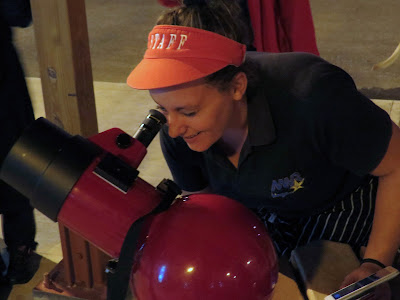 |
| The tour group gathers outside the Visitor Centre |
I have a confession which may not come as a surprise to those who have reason to know me well; I'm in love with big, vintage refractor telescopes. Yes, I know that the reflector revolution of the early 20th Century displaced traditional refractors from the forefront of astronomical research; supplanting the long, graceful tubes and flint lenses that had ruled the skies since Galileo first focused on the heavens with gigantic mirrors and lattice-work tubes balanced on squat mountings in enormous domes atop high peaks.
I realize that this new age of astronomy--from Mount Wilson to Keck and even Hubble--has expanded our knowledge and understanding of the Cosmos; that the giant mirrors have provided the data which support the expanding Universe, Big Bang, and even Dark Matter theories. And I know that this trend will continue as larger and even larger reflector telescopes take their places on mountain tops around the world. Literally, the age of the large refractor is done.
So, perhaps my astronomical soul belongs to the 19th Century...
As I travel the world I take great pleasure in visiting observatories where ever I can, and although I am always appreciative of their facilities, the dedication of their staffs, and their efforts at education and "outreach", my eagerness to visit and (if I am fortunate) observe through their telescopes is always heightened by the discovery that the instruments in question are large, powerful refractors. I can't help it; these big 'scopes get my astronomical juices flowing.
 |
| The dome of the Doridis Telescope |
Last night I was privileged to be able to tour the National Observatory of Athens' Thissio Visitor Centre, located atop Nymphs' Hill--adjacent to the famous Acropolis--and to observe through their impressive 16-inch
Doridis refractor. I found myself quite excited at this prospect--so excited that I actually arrived at Nymph's Hill nearly an hour and a half before gates were to open!
This, however, was not a problem. I rested on the rocky hilltop near the
Doridis dome and admired the sunset and twilight; Mars and Venus were gleaming in the south and west while the spotlights illuminating the nearby Acropolis came up with a golden glow, and as Athens' lights came up below me I thought back to the skies that citizens of the ancient city must have viewed, so long ago. On this night I was hard-pressed to pick out any stars more dim than second magnitude!
 |
| The Syggros Meridian (transit) Telescope |
I was quite pleased to see that our tour group consisted of nearly twenty people, of all ages. Later I was to learn that at least two more groups were expected during the evening, raising the expected turnout to over one hundred! According to a staff member that I spoke to later, on special events nights (such as the recent Super Moon) the tally can reach well over a thousand guests. Bravo!
 |
| A Super-Scale Model of the Antikythera Mechanism |
The tour of the Visitor Centre was fascinating; we visited the special observing room where astronomers, using the Meridian Telescope, would time the passages of selected stars across the meridian in order to determine the precise time in Athens (the time would in turn be announced from the catwalk around the roof-top dome by the raising and lowering of a ball on the mast there). We saw a precise reconstruction of the famous Antikythera Mechanism based on the latest research into this amazing find from ancient Greece.
We examined scientific instruments from the nearly two centuries' constant service in the Observatory, and the amazing lunar map generated over three years' observation and sketching by Julius Schmidt in the third quarter of the 19th Century.
And finally, to top the evening off...
 |
| The Doridis Telescope focuses on Cygnus |
Back out under the stars we trooped, out of the Visitor Centre and across the rugged hilltop to the
Doridis dome. There Tsimpidas Dimitrios, our observer for the evening, talked to us whilst opening the redwood-paneled dome and taking aim at the binary star system of Albireo (
b Cygni). While he guided the first observers to the eyepiece and demonstrated how to "breath out--and hold it" while gazing through the 'scope, I enjoyed the view of the long "eye" of
Doridis, reaching toward the slit in the dome and onward to Cygnus!
Standing near the housing of the telescope's mount I could hear the whirr of its motors as they tracked their distant target across the western sky, and note the subtle, almost un-noticeable motion of the tube across the strip of sky visible through the slit. I think this is my favorite part of my visits to observatories and attendance at star parties; that rare sensation of being for a moment "lost in space", a delightfully vertiginous experience.
When my turn at the eyepiece came at last I was already wholly satisfied with the night's progress; the view of two brilliant stars--one yellow and one blue--centered in the eyepiece was the icing on the cake as far as I was concerned. Just beautiful!
A while later, having signed the observatory guest book and said goodbye to Tsimpidas and the other present members of the staff, I started off down the Hill of Nymphs and began the long walk back to the pick-up point for the bus back to the ship. My first night in Athens was a terrific success, and I'm looking forward to the rest of my visit in this remarkable city; this wonderful mix of old and new, ancient and modern.



































